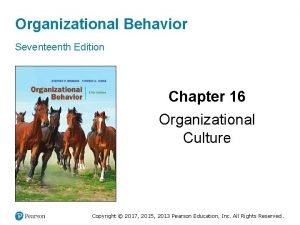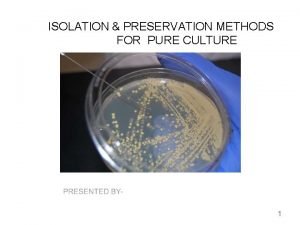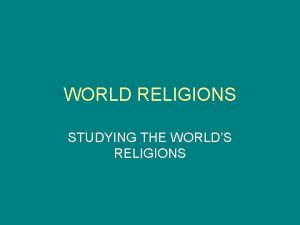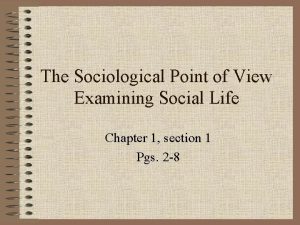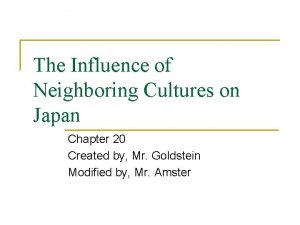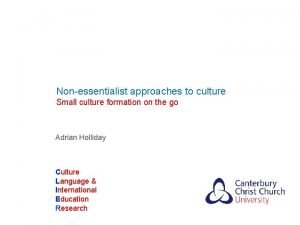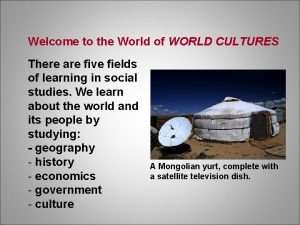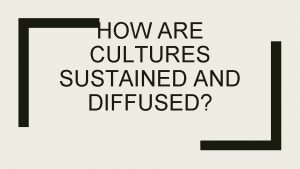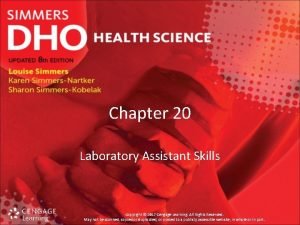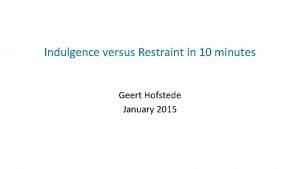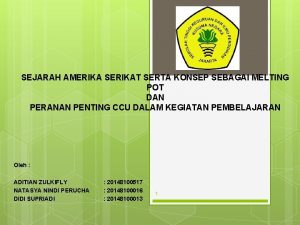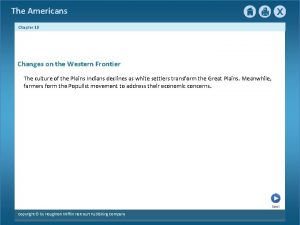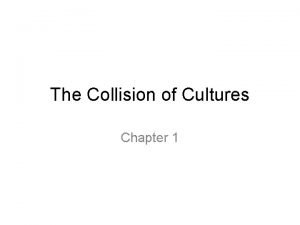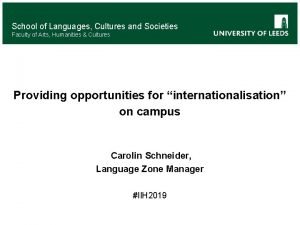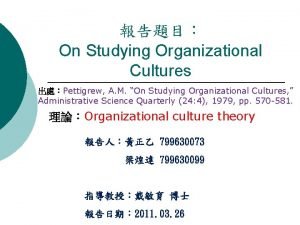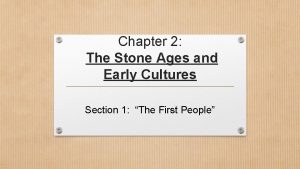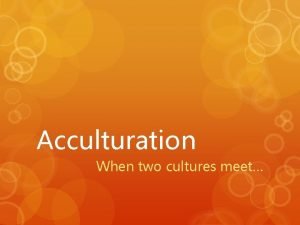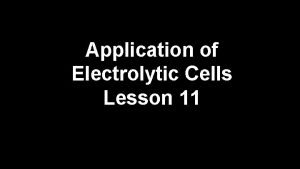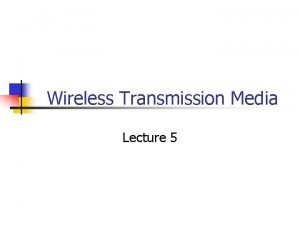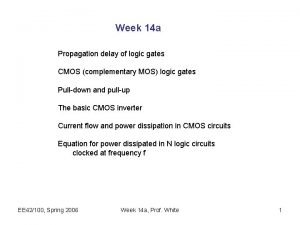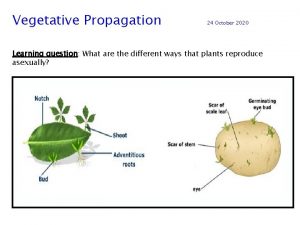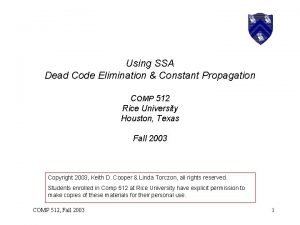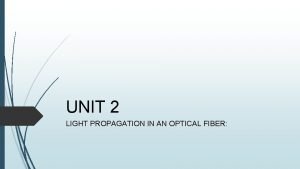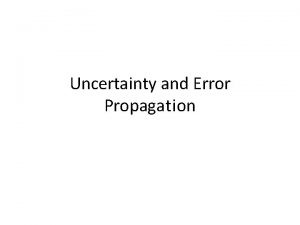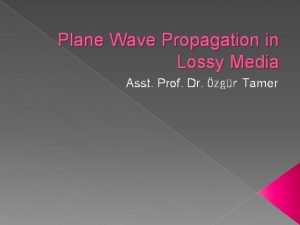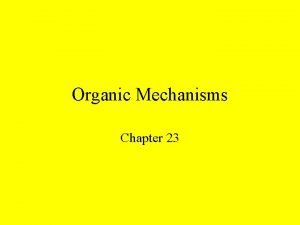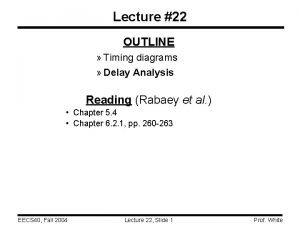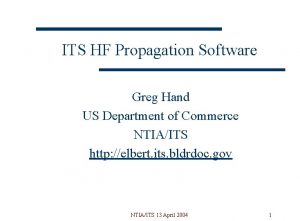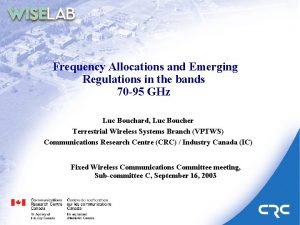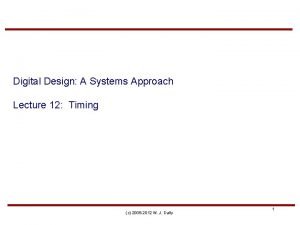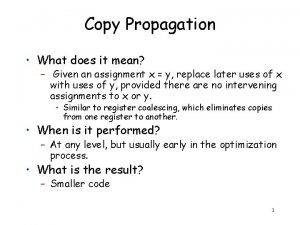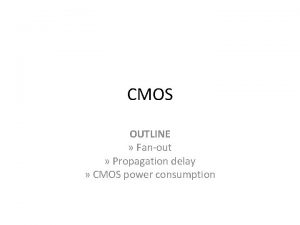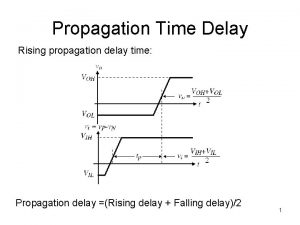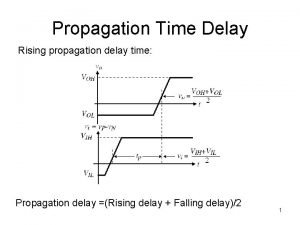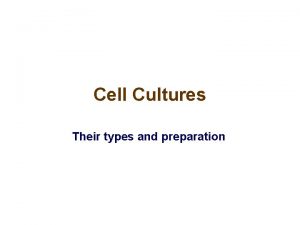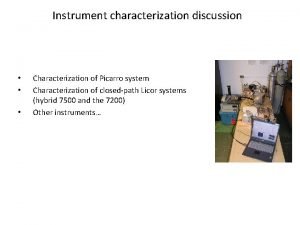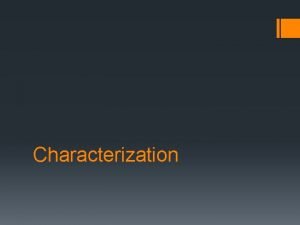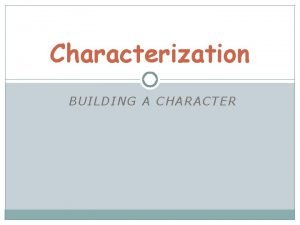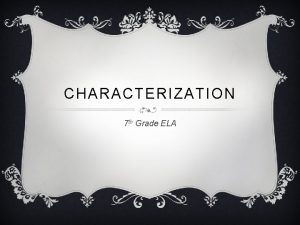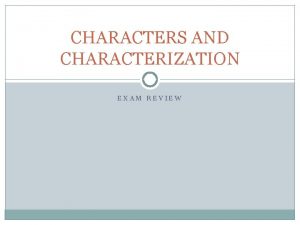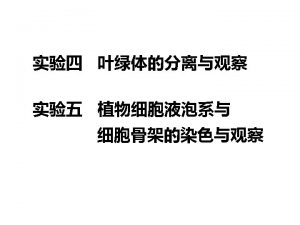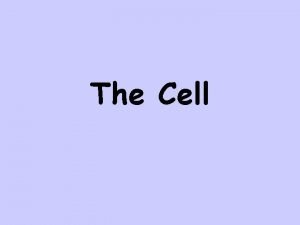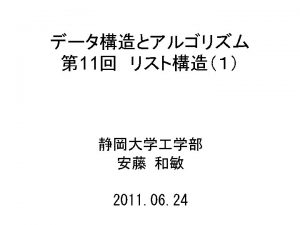P 01Primary cell cultures Isolation Characterization Propagation Application













































































- Slides: 77

P 01_Primary cell cultures: Isolation – Characterization – Propagation Application Cell culture techniques: Understanding how our cells function (Research) Looking for active compounds (Screening) Production of Biopharmaceuticals (Production) * Molecular Cell- and Tumour Biology * Summer 2013 * Naples* 1

P 01_Primary cell cultures: Isolation – Characterization – Propagation Application • At the beginning: chicken embryo tissue culture • He. La and Eagle: 50 years with permanent cell lines • Epigenetic factors: indispensable for cell differentiation • Primary cell cultures: how to get them from tissue • The social behavior of cells: Co Cultivation and ECM • Movement: Migration and Invasion • From 2 D to 3 D: Emulation of the tissue • Gene expression and function: functional genomics • The future of cell culture: Good Cell Culture Practice * Molecular Cell- and Tumour Biology * Summer 2013 * Naples*

P 01_Primary cell cultures: Isolation – Characterization – Propagation Application At the beginning: chicken embryo tissue culture Benefits • Maintenance of histological structures • All cells present • cell interactions • cells remain attached to ECM and disadvantages • Microscopic monitoring impossible • Uncontrolled environment • no quantification • heterogeneous cell population of tissue cultures * Molecular Cell- and Tumour Biology * Summer 2013 * Naples*

P 01_Primary cell cultures: Isolation – Characterization – Propagation Application He. La and Eagle: 50 years with permanent cell lines Some major benefits of these technology • Dissociation of the tissue provides single cell suspensions • Cells grow adherent (most) on chemically modified surfaces • well defined cell culture medium inhibited bacterial growth • Actually more than 3. 000 cell lines available • Freezing and storage in nitrogen • High throughput screening and bio production • cell culture technique established as a routine lab work • reduction of experiments on animals • used in HTS and vaccine production * Molecular Cell- and Tumour Biology * Summer 2013 * Naples*

P 01_Primary cell cultures: Isolation – Characterization – Propagation Application Starting modern flat cell culture systems George Otto Gey (1899 -1970) 9. Februar 1951 Otto Gey and his wife 1950 s they started the Tissue Culture Laboratory *Henrietta Lackst * Molecular Cell- and Tumour Biology * Summer 2013 * Naples* 5

P 01_Primary cell cultures: Isolation – Characterization – Propagation Application He. La and Eagle: 50 years with permanent cell lines The major drawbacks of these technology: • some (most? ) of the cell lines proved to be genetically unstable • cross contamination as a result of „bad handling“ • contamination with mycoplasms • loss of differentiation • cell culture media not really standardized • replacement of experiments using animals limited • “in vitro” fails to reflect “in vivo” • GCCP may diminish some of these limitations ECM : Extracellular macromolecules as matrix are necessary * Molecular Cell- and Tumour Biology * Summer 2013 * Naples*

P 01_Primary cell cultures: Isolation – Characterization – Propagation Application Primary cell cultures: how to get them from tissue • Removal of organs or samples from surgery • sampling of tumour specimens • crude preparation of regions of interest • dissociation using enzymes • separation of cells according to surfaces molecules (Immunosorting) • cultivating on coated surfaces • cultivation in specific serum free medium • selection of cells of „interest“ • controlling gene expression profile CAVE: Usually 2 6 subcultures are useable Actually a lot of primary cell cultures in low passages are available * Molecular Cell- and Tumour Biology * Summer 2013 * Naples*

P 01_Primary cell cultures: Isolation – Characterization – Propagation Application Primary cell cultures: how to get them from tissue Some major problems and limitations using primary cell cultures: 1 Selection of cells of interest within a heterogeneous population 2 Damaging of the cells during enzymatic treatment 3 Loss of important cell populations 4 Rapid change in gene expression profile within hours 5 Limited material available 6 Ethical limitations 7 Time consuming and expensive 8 Standardization and quality control complex Only adult stem cells will start to divide and grow in vitro! * Molecular Cell- and Tumour Biology * Summer 2013 * Naples*

P 01_Primary cell cultures: Isolation – Characterization – Propagation Application P 01. 1: Primary Cell Cultures vs. permanent cell lines A classification • Primary Cell Cultures: – Cells grow out of the tissue/organ – Cells have a limited lifespan / passaging potential – Cells are representative for the tissue of origin – Cells are differentiated or cells can be differentiated • Cell lines (permanent): – Spontaneous or immortalized – permanent – really? – Genetically modified – Genetically stable? * Molecular Cell- and Tumour Biology * Summer 2013 * Naples*

P 01: Primary Cell Culture P 01. 1 Cell lines It all started with He. La but it was a happy accident! • largely from human tumor tissue • genetically heterogeneous • usually represent a cellular subtype • loss of differentiation a priori or over passaging • stability problems in long term cultivation • precise correlation in the absence of appropriate controls is often poorly • easy to augment almost indefinite available • nearly no Batch to Batch variations when using SOPs • immortalization not representative for normal tissue • therefore, HTS compatible * Molecular Cell- and Tumour Biology * Summer 2013 * Naples*

P 01: Primary Cell Culture P 01. 1 Primary Cell Culture It all started with Roux (1885): chicken embryos in glass bottles! And today? Why “back to the roots” of cell culture technologies? • regenerative medicine (SKIN) see PPP 12. 09. 2013 • replacement of animal experiments (ECVAM) • stem cell research (myocardium) • Searching for therapeutic targets (tumor stem cell) • molecular medicine • in vivo like models in parallel to animal experiments • … and much more… * Molecular Cell- and Tumour Biology * Summer 2013 * Naples*

P 01: Primary Cell Culture P 01. 1 Primary Cell Cultures – how it all began Design of an artificial skin. I. Basic design principles I. V. Yannas, John F. Burke (1979) Skin Grafting for Full Thickness Burn Injury Maribeth Wooldridge, Judith A. Surveyer Nov. , 1980 The Use of "Artificial Skin" for Burns T Jaksic, and J F Burke Vol. 38: 107 117 (Volume publication date February 1987) * Molecular Cell- and Tumour Biology * Summer 2013 * Naples*

P 01: Primary Cell Culture P 01. 1 Primary Cell Culture • targeted isolation of single, differentiated cell subpopulations • propagation in vitro • maintenance of function and differentiation • combination with other cells (co culture, TE) • autograft transfer • immortalization • storage * Molecular Cell- and Tumour Biology * Summer 2013 * Naples*

P 01: Primary Cell Culture P 01. 1 Primary Cell Culture Some important (even ethical) aspects: • Where does the tissue come from? animal / human • healthy tissue or malignant tumor? • „Informed consent“ from donator/patient • positive vote of the der ethics commission • access to tissue banks (institutions/private/commercial) • purchase from commercial suppliers of Primary Cell Cultures • control of the der Batch to Batch variability * Molecular Cell- and Tumour Biology * Summer 2013 * Naples*

P 01: Primary Cell Culture P 01. 1 Primary Cell Culture Some important (even ethical) aspects : • tissue from donators rather unproblematic • agreement and hygienic controls (HIV) • some tissue are always problematic: hepatocytes! • variability can be very large: age + gender • fetuses: the material from which dreams/nightmares are made • do stem cells really solve the problem? * Molecular Cell- and Tumour Biology * Summer 2013 * Naples*

P 01: Primary Cell Culture P 01. 1 Primary Cell Culture Some important aspects: non-critical material • donation skin after plastic surgery (breast, bottom, belly) • foreskin of boys (post partem until a few years) • endothelium from umbilical cord • adipocytes from donation tissue • hematopoietic cells from blood, bone marrow, cord blood • urothelial cells from bladder irrigations • alveolar cells from lung grafts * Molecular Cell- and Tumour Biology * Summer 2013 * Naples*

P 01: Primary Cell Culture P 01. 1 Primary Cell Culture Some important aspects: critical material hepatocytes from liver tissue • intestinal epithelium • myocardial tissue • differentiated tissue of internal organs • nerve tissue • tumor biopsies – smaller and smaller…. Biobanking can help to propagate Fetal tissue (abortion material) after vote of the ethics commission Adult / neonatal stem cells? * Molecular Cell- and Tumour Biology * Summer 2013 * Naples*

P 01: Primary Cell Culture P 01. 1 Primary Cell Culture Crucial question: Why? AIM and GOAL • fundamental research: TUMOR BIOLOGY • target screening • drug control • regenerative medicine • commercial/non commercial difficult to distinguish • genetic reprogramming could solve the quandary! * Molecular Cell- and Tumour Biology * Summer 2013 * Naples*

P 01: Primary Cell Culture P 01. 2 Primary Cell Culture Before you start: Biopsy, transport, storage: SOP • What tissue type? • Accessibility? • Who characterizes/carries out the biopsy? • Environment (contamination)? • Wherein should the tissue be stored/removed? • Tissue stability (autolysis)? • Organization of the transport? • How long can the tissue temporarily be stored? * Molecular Cell- and Tumour Biology * Summer 2013 * Naples*

P 01: Primary Cell Culture P 01. 2 Primary Cell Culture Biopsy, transport, storage: SOP What tissue type? • the better characterized, the more easily the Primary Cell Culture! • the more complicated the composition, the more difficult the selection • the fresher the tissue, the more successful the Primary Cell Culture * Molecular Cell- and Tumour Biology * Summer 2013 * Naples*

P 01: Primary Cell Culture P 01. 2 Primary Cell Culture Biopsy, transport, storage: SOP Accessibility? Who characterizes/carries out the biopsy? • good knowledge of the objective is advantageous • short routes • pathologist/surgeon/veterinarian as contact person • what are the quantities required? • the better the primary isolation, the more successful the cultivation! * Molecular Cell- and Tumour Biology * Summer 2013 * Naples*

P 01: Primary Cell Culture P 01. 2 Primary Cell Culture Biopsy, transport, storage: SOP Environment (contamination)? Wherein should the tissue be stored/removed? • sterile environment is required! • maybe problems in the animal facility • even set up a sterile laboratory in the pathology! • surgical sterility is not identical to cell culture sterility • sterility controls obligatory • add 2 4 x antibiotics to the medium for transport • no fungicide * Molecular Cell- and Tumour Biology * Summer 2013 * Naples*

P 01: Primary Cell Culture P 01. 2 Primary Cell Culture Biopsy, transport, storage: SOP Tissue stability (autolysis)? • controls required (e. g. RNA stability) • keep cool and dry • no general predication possible • fibroblasts cultures can be established until 48 h post mortem • endothelial cells from umbilical cord can be established until 96 h after birth • standardization required (see transport) * Molecular Cell- and Tumour Biology * Summer 2013 * Naples*

P 01: Primary Cell Culture P 01. 2 Primary Cell Culture Biopsy, transport, storage: SOP Organization of the transport? • docket required • use suitable transport vessels! • log temperature and time • the faster the better: 30 min after biopsy on the benchtop! • responsibility, preparation of the laboratory • overnight express possible • observe hygiene regulations! * Molecular Cell- and Tumour Biology * Summer 2013 * Naples*

P 01: Primary Cell Culture P 01. 2 Primary Cell Culture Biopsy, transport, storage: SOP How long can the tissue temporarily be stored in our lab? • according to tissue type 30 min up to 4 days • watch the p. H stability of the medium (+HEPES) • full medium required • maybe preparation of the tissue ( fat tissue, erythrocytes etc. ) • photo documentation • take sterility controls • SOP for everything! * Molecular Cell- and Tumour Biology * Summer 2013 * Naples*

P 01: Primary Cell Culture Tumor Umbilical vein * Molecular Cell- and Tumour Biology * Summer 2013 * Naples* Lung cancer 26

P 01: Primary Cell Culture P 01. 3 Strategy for the preparation of a single cell suspension: Cells are united in the tissue • cell matrix connection through hydrophilic interactions (integrine) • cell interaction through homophile interactions (cadherine) mechanical fragmentation with scalpel mechanical fragmentation with scissors mechanical fragmentation through shear force (soft tissue) +/ enzymatic cell disruption (perfusion) * Molecular Cell- and Tumour Biology * Summer 2013 * Naples*

P 01: Primary Cell Culture Cell and Cell Matrix Interactions * Molecular Cell- and Tumour Biology * Summer 2013 * Naples*

P 01: Primary Cell Culture Cell Isolation out of a tissue: Where is my cell of interest? * Molecular Cell- and Tumour Biology * Summer 2013 * Naples*

P 01: Primary Cell Culture Preparation Cell adherence Enzymatic digestion Preparation of single cell suspension * Molecular Cell- and Tumour Biology * Summer 2013 * Naples* 30

P 01: Primary Cell Culture P 01. 3: Strategy for the preparation of a single cell suspension mechanical fragmentation with scalpel • Previously, cut tissue samples into small pieces with (if necessary) • optical control with magnifying glass • removing of macroscopic/microscopic different tissue • cut small pieces while avoiding severe trauma • tissue samples may not dry out • use HEPES buffered medium (p. H stability) • compromise between small samples (low diffusion) and trauma • cutting tissue with scissors leads to the crushing of the tissue * Molecular Cell- and Tumour Biology * Summer 2013 * Naples*

P 01: Primary Cell Culture P 01. 3: Strategy for the preparation of a single cell suspension: Enzymatic dissociation of cells from the tissue (1) • no highly specific enzymes known • trypsin is an unspecific protease, effective but toxic • collagenases specifically digest some matrix proteins • dispase is dissolving cell matrix interactions, but not the homophilc cell adherence • elastase pre treatment • variability in concentration, time and temperature • pre treatment with cold solutions could reduce the toxic actions • total digestion of matrix proteins generally not recommended • enyzmes should be tested before (Lot variability) * Molecular Cell- and Tumour Biology * Summer 2013 * Naples*

P 01: Primary Cell Culture Enzymes used for tissue digestion: Pronases: Neutral metalloprotetase derived from Streptomyces griseus. P. Cleaves predominantly peptid-bonds neighbored to hydrophobe amino acids Elastases: Cleaves peptid-bonds on the carboy-end of samll hydrophobic aa like e. g. Glycin, Alanin, Valin. . efficacy rather unspecific which causes damage of the cells. Collagenases: Collagenases are endopeptidases that digest native collagen in the triple helix region. Collagens are the major fibrous component of animal extracellular connective tissue. Trypsin: Summary of a class of endopeptidases which cleave proteins at definded sequences e. g. near serine: Unspecific which marked unwanted side effects and cell damage! * Molecular Cell- and Tumour Biology * Summer 2013 * Naples*

P 01: Primary Cell Culture P 01. 3: Strategy for the preparation of a single cell suspension: Enzymatic dissociation of cells from the tissue (2) • resuspend suspension with pipettes (big notch) after digestion • staining cell suspension with cell strainer of different pore size • rinse sieve with medium (inactivation of the enzyme solution) • microscopic control of the yield in the flow through • treat the remaining tissue samples with strainer • alternatively, rinse and use as a particle culture • count and seed cells, probably further purification by MACS/FACS * Molecular Cell- and Tumour Biology * Summer 2013 * Naples*

P 01: Primary Cell Culture P 01. 3: Strategy for the preparation of a single cell suspension: Enzymatic dissociation of cells from the tissue (3) PERFUSION • perfusion for the preparation of hepatocytes, endothelial cells, SMC`s • enzymes according to regulations, low concentration and short incubation time • note diffusion gradient (hepatocytes) • reduced temperature when treating vessels • cell straining generally not necessary • mechanical support can be helpful (massage) • generally good yield and pure cell population * Molecular Cell- and Tumour Biology * Summer 2013 * Naples*

P 01: Primary Cell Culture P 01. 3: Strategy for the preparation of a single cell suspension: Enzymatic dissociation of cells from the tissue(4) Examples Perfusion • endothelial cells from umbilical cord • SMC`s from umbilical cord Mechanical fragmentation and diffusion • keratinocytes from skin • fibroblasts from skin * Molecular Cell- and Tumour Biology * Summer 2013 * Naples*

P 01: Primary Cell Culture P 01. 3: Strategy for the preparation of a single cell suspension: Enzymatic dissociation of cells from the tissue (5) Examples – overview of the enzymes see additional supplement enzyme concentration reaction conditions Trypsin 0, 25% in PBS 16 - 18 h at 4 °C, then 30 min 37°C Collagenase 100 U/ml medium over night 37°C Dispase 2 U/ml PBS over night 4°C Thermolysin 0, 5 mg/m. L in HEPESBuffer over night 4°C * Molecular Cell- and Tumour Biology * Summer 2013 * Naples*

P 01: Primary Cell Culture P 01. 4: Strategies for Selection - a challenging work Ambition: Enrichment of the desired cell population • macroscopic/microscopic fractionation • different speed for detachment of the cells (endothelial cells/SMC) • different stability concerning the used enzymes • different speed for adherence (macrophages) • different preference of the surface (coating) • different density (Ficoll, centrifugal elutriation) • different surface marker (FACS, MACS) • different cell culture media • isolation of single clones (“cloning rings”) • isolation of single clones (micro dissection) • selective trypsinization • other selection procedures * Molecular Cell- and Tumour Biology * Summer 2013 * Naples*

P 01: Primary Cell Culture P 01. 4: Strategies for Selection Ambition: Enrichment of the desired cell population • macroscopic/microscopic fractionation The mechanical pretreatment is usually the first and the most important step in the selection * Molecular Cell- and Tumour Biology * Summer 2013 * Naples*

P 01: Primary Cell Culture P 01. 4: Strategies for Selection Ambition : Enrichment of the desired cell population • different speed for detachment of the cells (endothelial cells/SMC) Preferred selection through perfusion. The penetration of the enzyme can be controlled by variation of the incubation time. Optimal time/concentration temperature combination has to be determined. Good and pure separation is possible, if the different cell types are stratified (skin, vessels) * Molecular Cell- and Tumour Biology * Summer 2013 * Naples*

P 01: Primary Cell Culture P 01. 4: Strategies for Selection Ambition: Enrichment of the desired cell population • different sensitivity concerning the used enzymes The combination of different enzymes may preferably promote the selective isolation of single cell types. In fact, this principle is an enrichment, the contamination with undesired cell types is likely. Preferably for heterogeneous tissue (lung, tumors). * Molecular Cell- and Tumour Biology * Summer 2013 * Naples*

P 01: Primary Cell Culture P 01. 4: Strategies for Selection Ambition: Enrichment of the desired cell population • different speed for adherence Successful strategy, especially in combination with coating Combination with antibodies also successfully tested (panning) Can be used as positive or negative selection as well Is also described for the removal of macrophages from lung tissue Time must be determined empirically Selection markers must be present * Molecular Cell- and Tumour Biology * Summer 2013 * Naples*

P 01: Primary Cell Culture P 01. 4: Strategies for Selection Ambition: Enrichment of the desired cell population • different preference of the surface (coating) Surface is defined in terms of charge and matrix Cells have got a different Zeta potential Cells differ in their integrin configuration No all or nothing principle combination with time factor to favor * Molecular Cell- and Tumour Biology * Summer 2013 * Naples*

P 01: Primary Cell Culture Coating He. La and Eagle: 50 years with permanent cell lines The major drawbacks of these technology: • some (most? ) of the cell lines proved to be genetically unstable • cross contamination as a result of „bad handling“ • contamination with mycoplasms • loss of differentiation • cell culture media not really standardized • replacement of experiments using animals limited • “in vitro” fails to reflect “in vivo” • GCCP may diminish some of these limitations ECM : Extracellular macromolecules as matrix are necessary * Molecular Cell- and Tumour Biology * Summer 2013 * Naples*

P 01: Primary Cell Culture Signaltransduction from ECM to the genome by integrins Actin * Molecular Cell- and Tumour Biology * Summer 2013 * Naples* Actin

P 01: Primary Cell Culture ECM as Epigenetic factors: indispensable for cell differentiation Integrins trigger Differentiation Apoptosis and Proliferation Apoptosis Ligands for Integrins: Collagen Laminin Fibronectin v. WF Vitronectin Fibrinogen Fibronectin RGD`s ICAM VCAN 1 …… * Molecular Cell- and Tumour Biology * Summer 2013 * Naples*

P 01: Primary Cell Culture ECM as Epigenetic factors: indispensable for cell differentiation Some major benefits of using ECM-coating • more standardized than „self coating“ by FCS • surface adapted to a specific cell type • inhibition of apoptosis • growth rates are adapted to in vivo values • improved differentiation • improved adhesion • reversion to a biological response * Molecular Cell- and Tumour Biology * Summer 2013 * Naples*

P 01: Primary Cell Culture ECM as Epigenetic factors: indispensable for cell differentiation Some common coating techniques: • Matrigel ™ to mimic basal membranes containing collagen IV • Proteoglycanes and Glycoproteins • Collagen I as the major component of the connective tissue • Fibronectin as adhesion molecules for fibroblasts • Laminin enables adherence of epithelial cells by “RGD motifs” Matrigel™ and Collagen I can be used as thin or thick (gel) coating Influence on cellular behaviour depends on the ECM concentration Problems: How can we standardise the protocols i. e. concentration, thickness, stability? * Molecular Cell- and Tumour Biology * Summer 2013 * Naples*

P 01: Primary Cell Culture ECM as Epigenetic factors: indispensable for cell differentiation Some common features of ECM coating • Matrigel ™ induces cell specific gene expression (PSA in prostate) • Matrigel ™ reduce proliferation in primary cell cultures • Matrigel ™ allows tube formation in thick gels • Matrigel ™ can be used as a barrier in invasion assays • Matrigel ™ modulates signal transduction • Matrigel ™ influences shape and orientation Important: Even permanent cell lines respond to ECM coating Thus coating may be a helpful parameter in HTS * Molecular Cell- and Tumour Biology * Summer 2013 * Naples*

P 01: Primary Cell Culture ECM as Epigenetic factors: indispensable for cell differentiation The future of ECM coating Modification of cell culture surfaces by Microstructuring and Nanomodification Coated with Si 3 N 4 * Molecular Cell- and Tumour Biology * Summer 2013 * Naples*

Characterization by immunostaining * Molecular Cell- and Tumour Biology * Summer 2013 * Naples* 51

Morphology of different tumor cells in primary cell culture * Molecular Cell- and Tumour Biology * Summer 2013 * Naples* 52

Detailed microscopy examination Mitosis Cell nucleus * Molecular Cell- and Tumour Biology * Summer 2013 * Naples* 53

P 01: Primary Cell Culture Tissue engineering and Regenerative Medicine Support of normal Tissue regeneration by adult stem cells Organ-replacement Alternative for animal experiments CELLS + Matrix * Molecular Cell- and Tumour Biology * Summer 2013 * Naples* 54

Cell Banking * Molecular Cell- and Tumour Biology * Summer 2013 * Naples*

Master Bank * Molecular Cell- and Tumour Biology * Summer 2013 * Naples*

Working Bank * Molecular Cell- and Tumour Biology * Summer 2013 * Naples*

Cells * Molecular Cell- and Tumour Biology * Summer 2013 * Naples*

Freezing and thawing • The basic principle of successful cryopreservation is a slow freeze and quick thaw • As a general guide cells should be cooled at a rate of • 1°C to -3°C per minute Cell density: 1 – 10 x 106 cells/ml * Molecular Cell- and Tumour Biology * Summer 2013 * Naples*

Cell Banking • Use cells only in best quality Morphology – Viability >90% – Free of any Contamination – Free of Mycoplasms • Use cells during growth phase – Pre confluent – Change of cell culture media 24 h prior freezing * Molecular Cell- and Tumour Biology * Summer 2013 * Naples*

Procedure • The day before freezing, reefed the cells with fresh medium to ensure that they are in log phase of growth. • Chill the Freezing medium on ice. • Label with Cryotubes with the cell line name, the cells/vial, and the date. • Prepare a single cell suspension, use Trypsin for adherent cell line. • Take an aliquot for a cell count. Count the cells. • NOTE: The cells must have greater than 90% viability before proceeding. If the cells are less than 90% viability, do not freeze. * Molecular Cell- and Tumour Biology * Summer 2013 * Naples*

Procedure • • Transfer the cell suspension to centrifuge tubes. Centrifuge at 1000 rpm for 5 minutes, 2 8 o. C. Siphon off all the medium. Slowly add chilled freezing medium to yield 5 x 106 cells/ml. Resuspend the cells by gently pipetting. Place the tube on ice. Dispense the cells, 1 ml/vial, into the labelled cryovials. Recap vials tightly. Complete all vials. Place the vials into the Nunc Freezing Container or Rate Controlled Freezer Racks. Place the Freezing Container in the 700 C Freezer overnight. Transfer the vials to the liquid nitrogen freezer. * Molecular Cell- and Tumour Biology * Summer 2013 * Naples*

Cell Banking * Molecular Cell- and Tumour Biology * Summer 2013 * Naples*

Cell Banking Cooling rates * Molecular Cell- and Tumour Biology * Summer 2013 * Naples*

Cell Banking Cooling rates * Molecular Cell- and Tumour Biology * Summer 2013 * Naples*

Cell Banking Freezing Box “Mister Frosty!” • Suitable for slow cooling rates about 1°C/min * Molecular Cell- and Tumour Biology * Summer 2013 * Naples*

Changes during freezing/thawing of water/ice * Molecular Cell- and Tumour Biology * Summer 2013 * Naples*

During freezing there occurs a shift in temperature named “solidification heat” Na. Cl Saccharose * Molecular Cell- and Tumour Biology * Summer 2013 * Naples*

Controlled freezing Strongly recommended for primary cells! * Molecular Cell- and Tumour Biology * Summer 2013 * Naples*

Controlled freezing * Molecular Cell- and Tumour Biology * Summer 2013 * Naples*

Controlled freezing * Molecular Cell- and Tumour Biology * Summer 2013 * Naples*

Ultra-low Temperature Storage * Molecular Cell- and Tumour Biology * Summer 2013 * Naples*

P 01: Primary Cell Culture Storage and quality control * Molecular Cell- and Tumour Biology * Summer 2013 * Naples*

P 01: Primary Cell Culture * Molecular Cell- and Tumour Biology * Summer 2013 * Naples*

P 01: Primary Cell Culture * Molecular Cell- and Tumour Biology * Summer 2013 * Naples*

P 01: Primary Cell Culture * Molecular Cell- and Tumour Biology * Summer 2013 * Naples*

P 01: Primary Cell Culture * Molecular Cell- and Tumour Biology * Summer 2013 * Naples*
 Organizational cultures often reflect national cultures
Organizational cultures often reflect national cultures Pure culture
Pure culture Indirect characterization definition
Indirect characterization definition Direct characterization example
Direct characterization example Procedure for isolation of cells for in vitro culture
Procedure for isolation of cells for in vitro culture Sub cultures
Sub cultures Which cultures believe in reincarnation
Which cultures believe in reincarnation What is sociology perspective
What is sociology perspective In what ways did neighboring cultures influence japan?
In what ways did neighboring cultures influence japan? Muhammad islam founder
Muhammad islam founder Slidetodoc.com
Slidetodoc.com Which cultures believe in reincarnation
Which cultures believe in reincarnation Adrian holliday small cultures
Adrian holliday small cultures Taste different cultures
Taste different cultures What is culture
What is culture Individualistic culture definition
Individualistic culture definition Collectivistic cultures
Collectivistic cultures Recreational activities across cultures and genders
Recreational activities across cultures and genders Is buddhism monotheistic or polytheistic
Is buddhism monotheistic or polytheistic All cultures undergo
All cultures undergo Communicating across cultures - ppt
Communicating across cultures - ppt Body language across cultures respuestas
Body language across cultures respuestas How many cultures are there
How many cultures are there How are local cultures sustained
How are local cultures sustained High-context cultures emphasize nonverbal messages.
High-context cultures emphasize nonverbal messages. Chapter 20:12 measuring specific gravity
Chapter 20:12 measuring specific gravity Motivation in different cultures
Motivation in different cultures Words from many cultures weslandia answers
Words from many cultures weslandia answers Bacterial growth
Bacterial growth Postfigurative cultures
Postfigurative cultures Indulgence/restraint
Indulgence/restraint Georgia's prehistoric cultures chart
Georgia's prehistoric cultures chart Chapter 5 a clash of cultures
Chapter 5 a clash of cultures Guided reading activity the human world
Guided reading activity the human world Motivation across cultures
Motivation across cultures Social communities include a number of cultures.
Social communities include a number of cultures. Atakapans
Atakapans Meaning of melting pot of cultures
Meaning of melting pot of cultures Chapter 5 section 1 cultures of the mountains and the sea
Chapter 5 section 1 cultures of the mountains and the sea Cultures and organizations software of the mind
Cultures and organizations software of the mind Chapter 13 section 1 cultures clash on the prairie
Chapter 13 section 1 cultures clash on the prairie Words from many cultures
Words from many cultures Spoken poetry about cultural relativism
Spoken poetry about cultural relativism Motivation across cultures
Motivation across cultures Karin knorr cetina
Karin knorr cetina Confrontation of cultures
Confrontation of cultures The collision of cultures chapter 1
The collision of cultures chapter 1 Literacy shed zahra
Literacy shed zahra Tandem language
Tandem language Schein’s three levels of culture
Schein’s three levels of culture Values attitudes and job satisfaction
Values attitudes and job satisfaction Folk culture and popular culture venn diagram
Folk culture and popular culture venn diagram The stone ages and early cultures
The stone ages and early cultures What happens when different cultures meet
What happens when different cultures meet Applications of electrolytic cells
Applications of electrolytic cells What is a wireless transmission media
What is a wireless transmission media Propagation delay in logic families
Propagation delay in logic families Vegetative propagation mind map
Vegetative propagation mind map Sparse conditional constant propagation
Sparse conditional constant propagation The angle of acceptance cone is twice the
The angle of acceptance cone is twice the Gaussian error propagation
Gaussian error propagation Percentage uncertainty
Percentage uncertainty Sparse conditional constant propagation
Sparse conditional constant propagation Konstanta saluran transmisi
Konstanta saluran transmisi Rf propagation modeling software
Rf propagation modeling software Attenuation constant formula
Attenuation constant formula Cl free radical
Cl free radical Ethene hbr
Ethene hbr Propagation delay timing diagram
Propagation delay timing diagram Error propagation equation
Error propagation equation Its hf propagation
Its hf propagation Long path propagation
Long path propagation Rf propagation
Rf propagation Absolute error
Absolute error Propagation delay and contamination delay
Propagation delay and contamination delay Forward propogation
Forward propogation Copy propagation in compiler design
Copy propagation in compiler design Cmos power consumption
Cmos power consumption
